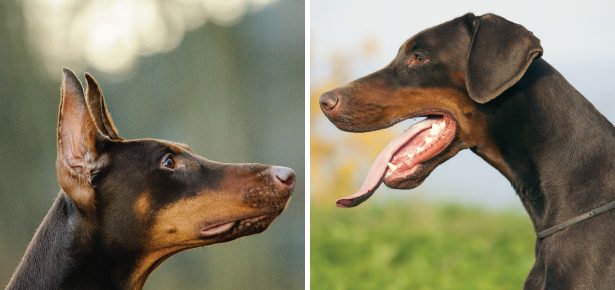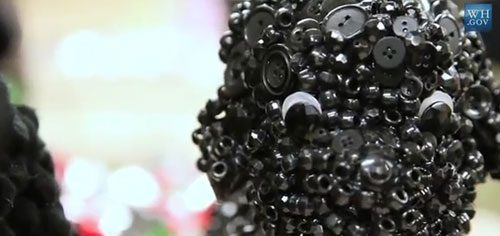

To Crop, or not to Crop?
What you decide influences how others view you.
Science shows people are judging you by your dog:
a new study demonstrates that docking a dog's tail or cropping his ears alters public perception—not just of the dog, but of the owner too
Suppose that you find yourself looking at a man standing next to a Harley-Davidson motorcycle. He is wearing a leather vest, but no shirt so that you can clearly see the multiple large tattoos covering his body. His face is scarred and he has a red bandanna covering his long, uncombed hair. Which pair of words do you think might best describe the personality you would expect this individual to have: "warm and cuddly" or "rough and dangerous?"
Appearances are important. They affect our first impression of people, how we judge their personality, and whether we respond positively or negatively to them. Scientific data shows that the same goes for dogs. This not only holds for the natural look of dogs but also how they look after human beings have intervened to modify their physical characteristics. Typical modifications often involve medical procedures to change the shape of a dog’s ears or the length of its tail. It seems that such alterations also change our perception of the temperament of these modified dogs. Recent scientific data suggests that docking the tails of dogs and cropping their ears causes people to judge the dog’s personality more negatively. Perhaps equally interesting is the fact that this impression carries over to the way that people judge the temperament and personality of the individuals who own such dogs.
Certain breeds of dogs have traditionally been surgically altered either to assist them in their designated working function, or to meet the aesthetic standards set out by particular kennel clubs. Dogs that were supposed to function as guard dogs often had their tails cut short (technically “docked”) because the presence of a tail could provide a handhold for “the bad guys” to control the dog while at the same time avoiding his teeth. These same dogs often had their ears surgically reshaped to minimize the size of the ear flaps (technically called “ear cropping”) because the flaps of the ears are very sensitive and could provide handholds for someone to control the dog's head position while still keeping away from the dog's teeth. These surgical procedures were also performed on dogs destined to be fight against dogs or other animals in the pit sports. Sometimes tail docking was done on hunting dogs in the belief that long tails were subject to damage as they went through dense underbrush and over rocky terrain.
“Dogs with the appearance typical of cropped and docked dogs might now be seen as more combative,
more dominant, and less playful & affectionate.”
Today such procedures are classified as medically unnecessary surgeries because their primary purpose is seen to be cosmetic. However, certain breed standards maintained by some kennel clubs include specifications regarding the length of the tail or the shape and position of the ears, and these can often only be attained by docking or cropping. It is likely that these aesthetic standards are still imposed upon these breeds simply because breeders have had their taste in what their breed of dog should look like shaped by the historical precedents. When these breeds originated, they were surgically modified because it seemed to improve the dog's ability to function in its assigned work, and now that “look” has come to be what breeders and breed fanciers expect and prefer, even though in contemporary society these dogs are now more likely to be used only as pets and companions.
The dogs which most typically had their tails docked or their ears cropped were the “tough guys of dogdom,” namely the guard dogs, fighters, and hunters. Because of that association it is natural that the attitudes of the average person toward individual dogs which have been modified in this way would be biased. Thus people would come to expect that any dogs that look like that will be ruffians and rowdies. In other words, dogs with the appearance typical of cropped and docked dogs might now be seen as more combative, more dominant, and less playful and affectionate.
Katelyn Mills, Jesse Robbins, and Marina von Keysrlngk, researchers in the Animal Welfare Program at the University of British Columbia in Vancouver, Canada, investigated the effect that docked tails and cropped ears have on our perception of the nature and personality of dogs, and then extended their research to see if these factors also had any effect on our perception of the dogs' owners as well. The results of their studies appeared in the journal PLoS ONE.
The researchers conducted several different surveys but I will concentrate on those which looked at the personality data. They presented pictures of four dog breeds that commonly have their tails docked and their ears cropped to their test subjects. Three of these breeds—the Boxer, Doberman Pinscher, and Miniature Schnauzer—are quite popular (in the top 20 registered breeds for the American Kennel Club) while the fourth, the Brussels Griffon, is not as common but provided them with an example of a toy breed that often undergoes these surgical changes. Researchers created two pictures of each dog breed, both in the same orientation and against the same background. The difference was that one of these dogs had cropped ears and docked tail while the other was a surgically unmodified dog.
In one survey, 392 U.S. residents served as test subjects. To conceal the aim of their study, the participants were told that they would be participating in an experiment to see whether or not it was possible to accurately predict the personality of dogs using nothing more than a photograph. Each test subject saw only four images that included just one version (natural or surgically modified) of each breed. They were then asked to rate each dog on a set of personality traits that were selected from a previously published dog personality questionnaire.
The results were consistent with the idea that seeing dogs with docked tails and cropped ears evokes a stereotype in people—one in which the altered dogs are seen as more belligerent and mean-spirited. According to their data, such modified dogs are believed to be more aggressive, both towards people and other dogs. They were also seen as being more dominant than natural, unmodified dogs. Furthermore, the natural dogs were reported as appearing to be more playful. Finally, seemingly flying in the face of any cosmetic purpose for the ear and tail surgeries, the natural unmodified dogs were rated as being more attractive than those who underwent docking and cropping.
Now here is where things get really interesting. In their final survey, the researchers decided to see if the way people judged the personalities of the surgically altered dogs also had an effect on how they judged the personality of the dogs’ owners. This time they surveyed 420 U.S. residents. The test subjects were informed that they would be participating in a study assessing whether an individual’s choice of a pet communicates information about their personality. In this study, a photo of either a natural or surgically modified dog was combined with a picture of a person. Participants were told that they would be seeing a picture of a real person (Karen or Brian) and their pet dog Pepper. In this study Pepper was represented by either a photo of a Doberman Pinscher in its natural state or as a tail docked and ear cropped dog of the same breed. The research participants were then given a list of questions about the personality of the dog's owner.
The results of this study suggest that observers tend to view the dog's owner as having much of the same characteristics that they attribute to the dog. Overall, the participants perceived the owners of dogs with cropped ears and docked tails as being more aggressive. They were also seen as more “narcissistic” where the experimenters used the definition of narcissism as “excessive self-admiration and feelings of superiority.” Furthermore, the owners of the modified dogs were judged as being less playful, less talkative, and less warm than the owners of the natural or unmodified dogs. The researchers summarize these results by saying that at least in the eyes of those individuals who observe the dogs and their owners together “it could be suggested that owners of modified dogs [appear to] have a greater risk of social conflicts, human interaction complications, and decreased approachability than owners of natural dogs.”
So if you are considering whether to dock your dog's tail or crop their ears this data suggests that by doing so you will be affecting much more than the way that your dog looks. Following such surgical modifications people are going to view your dog as having a more aggressive personality. In addition if you are seen to be associated with such a dog you are less likely to be perceived as warm and cuddly and more likely to be seen as a hard case. If you are concerned about how people respond to you and your dog, this might be something to think about.
Join the newsletter and never miss out on dog content again!
"*" indicates required fields
By clicking the arrow, you agree to our web Terms of Use and Privacy & Cookie Policy. Easy unsubscribe links are provided in every email.






